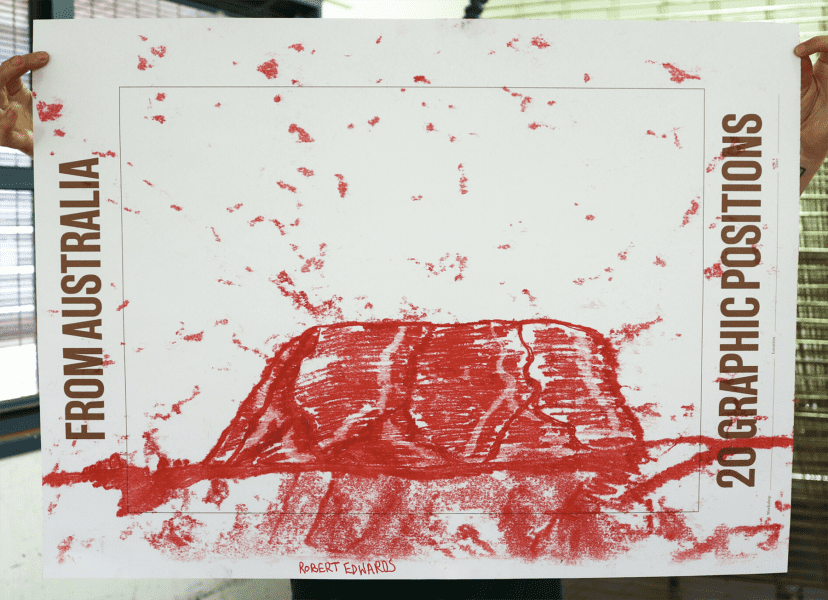
Material curiosities: Primavera 2025
In its 34th year, Primavera—the Museum of Contemporary Art Australia’s annual survey of Australian artists 35 and under—might be about to age out of itself, but with age it seems, comes wisdom and perspective.
In 1988 German curator René Block produced a print portfolio titled Aus Australien (From Australia). Featuring work by eight Australian artists, including John Nixon, Jenny Watson and Ken Unsworth, the collection presented the Australian art scene to a European audience, as well as marking the colonial bicentenary with a time capsule of national identity.
Three decades later, curator and printmaker Trent Walter is reimagining the project with From Australia: An Accumulation, in partnership with NETS Victoria. Featuring print commissions and work created through community workshops – and including one piece from each Aus Australien artist as a historical anchor – the exhibition tour rejects hierarchies to bring in perspectives that have historically been ignored.
“I’m not critical of those portfolios in terms of the artworks that they contain – it’s a very different context from 1988 to 2020 and 2021,” Walter says. “The critique lies in the structure and how you might approach it. If you are thinking about inclusivity, how do you approach something that is inherently limited? I’m not sure if there’s an answer that will ever satisfy the problem of trying to consider something so enormous, but I think it’s important to try.”
The exhibition also coincides with the recent 250th anniversary of Captain Cook’s voyage to Australia. With understanding of the detrimental and ongoing impacts of colonialism – especially on First Nations peoples – evolving, it’s a pertinent time to reflect on what so-called Australian national identity is. “Colonisation is implicit in the work that’s made, even if it’s not thought of consciously, because we all are in this colonised place and that influences social hierarchies, wealth and health outcomes,” the curator says.
From Australia begins at Latrobe Regional Gallery with commissioned prints by Alison Alder, Robert Fielding and Chips Mackinolty, alongside artworks from the community. Over the next two years, the exhibition will move throughout regional Victorian centres and evolve as it tours, with new professional commissions and workshop submissions in each location.

“It’s a methodology of accumulation, hence the title of the show,” Walter says. “It feels very true to a conversation that is continuing, rather than a full stop or presenting an archive of a project – it’s very much alive.
The public workshops are a critical aspect of the project. Since 2019, Walter has been running these events around the country, and he sees it as a way to include a more diverse and accurate cross-section of the community.
“We’re starting on the ground level,” he says. “There are people coming in to do the workshops who are usually in the community as cooks, or they’re not as heavily involved in the arts, but there are a lot of incredible artists there. It encourages a different engagement with how we think about art.”
Alison Alder’s work in the exhibition, The Rush That Must End, recreates the cover of a 1960s history book about Australian mining, with Alder’s own annotations and markings. The colourful print is her response to the politicisation of Indigenous cultural sites, in particular WA’s 46,000-year-old Juukan Gorge, in the name of capitalism and wealth.
“We need to think about the value of our cultural heritage – it’s worth more than iron ore,” she explains. “I’m resituating the work into a current context, sort of like a review of the past and what is happening now.”
The work has been printed by Walter onto fine paper, which has been laminated onto the surface of a heavier paper, giving it an added depth and liveliness. “It has an element of realism, but at the same time, it has really luscious and rich colours, and the notations are quite beautiful,” Alder says.
The Rush That Must End follows in the tradition of Alder’s previous works which, much like From Australia itself, recontextualise historical artefacts to make a statement about the current world. As a white Australian artist, she feels a responsibility to use her platform and privilege to speak out against the injustices continually enacted on First Nations people and sites.
“I just speak from my own perspective,” she says. “I feel so ashamed and disgusted about my position as a white person, and I should be campaigning to politicians that represent me, as they should represent everybody.”
In From Australia: An Accumulation, Walter aims to present an engaging experience that reflects the complexity and diversity of Australia today, as well as challenging the exclusivity of art practices and curation. Through collaborations and conversations with the wider community, a deeper understanding emerges.
“A lot of the questions are unresolved, and working through the project has given me an opportunity to test ideas on people,” he says. “Their ideas have influenced the project and the exhibition in really positive ways.
“There was a workshop participant who said, ‘just include everything’. What an incredible proposition. We’ve got so much work that there’s no space to hang everything, so how do we include as many people as possible and make sure we have at least one work by everyone? A lot of these principles and ideas are realised in concert with the people who are working on the project with me.”
From Australia: An Accumulation
Latrobe Regional Gallery
22 May – 1 August
Swan Hill Regional Art Gallery
15 August – 03 October
Queen Victoria Museum and Art Gallery
20 November – 20 February 2022
Mornington Peninsula Regional Gallery
05 March – 01 May 2022
Warwick Art Gallery
14 May – 09 July 2022
Riddoch Art Gallery
29 July – 10 September 2022
ANU School of Art & Design Gallery
28 September – 04 November 2022
Shepparton Art Museum
17 December – 19 February 2023